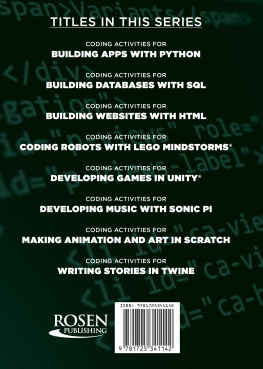Published in 2018 by The Rosen Publishing Group, Inc.
29 East 21st Street, New York, NY 10010
Copyright 2018 by The Rosen Publishing Group, Inc.
First Edition
All rights reserved. No part of this book may be reproduced in any form without permission in writing from the publisher, except by a reviewer.
Library of Congress Cataloging-in-Publication Data
Names: Poolos, Jamie, author.
Title: Designing, building, and maintaining websites / J. Poolos.
Description: New York : Rosen Central, 2018. | Series: Digital and information literacy | Includes bibliographical references and index. | Audience: Grades 5-8. Identifiers: LCCN 2017023103| ISBN 9781499439014 (library bound) | ISBN 9781499438994 (pbk.) | ISBN 9781499439007 (6 pack)
Subjects: LCSH: Web sites DesignJuvenile literature.
Classification: LCC TK5105.888 .B3795 2017 | DDC 006.7dc23 LC record available at https://lccn.loc.gov/2017023103
Manufactured in the United States of America
Contents
For a newcomer, the idea of creating a website from scratch can likely seem pretty overwhelming. However, anyone with an Internet connection can build one. Different types of sites requires different know-how, but all web pages and sites require the same basic knowledge.
A single web page can stand on its own, while a website is made up of many such pages. There are many different formats and forms a web presence can take online. A historical website about the Vietnam War hosted by the Public Broadcasting System (PBS) may be devoted to a single topic, for instance. However, it may have many different web pages comprising it, including transcripts, and links with video and other supplemental materials. Moving from one part of a website to another is done via the hyperlinks that usually pop up when you scroll over them with a mouse or a typepad on a computer, or use a touchscreen on a smartphone or tablet.
Web developers are the people that create websites. Most are professionals, but there are many that do it as a hobby, too. All of them must think carefully about what they hope to accomplish when developing a site. From its design, to its construction, and rolling it out for the use of others via publishing, this planning is integral to sites that work properly, look good, and are easy to use.
Web design is important to the look and feel of a site, but it is web developers that control what happens behind the scenes. One can compare the job of a web designer to that of a person who designs what a car might look like on the outside, versus the mechanical engineers and mechanics that concentrate on the parts under the hood that make automobiles run.
There are many factors to consider when creating websites. Beyond good graphic design, the coding provides the instructions that help accomplish what the users of the website need accomplished. Web developers usually need to know several programming languages these days to make good sites, and to make them reliable, efficient, quick, and responsive. They also need to know how to troubleshoot, fixing both standard problems and unexpected ones that may arise.
Many web developers study for years, and truly professional ones are always keeping up with the newest developments. But simple, effective websites are within the grasp of even inexperienced but dedicated students of web development. A few weeks or months of reading and studying can provide a budding young programmer with the basics needed to start out.
Once they do, building websites can be an exciting hobby and, naturally, a very rewarding and lucrative career path. Businesses, individuals, nonprofits, and government agencies all need websites built and maintained. With the Internet now a dominant part of modern life for billions of people worldwide, building web development skills and keeping them sharp will always be assets in high demand.
Websites: How They Work
W hen someone turns on their computer or other Internet-enabled device, opens a browser, they usually enter a website address in the appropriate field of the browser. That address can be loaded there. Web addresses also exist as link within the text and imagery of websites themselves. Click on them, or load an address via browsers like Google Chrome, Safari, Firefox, or Internet Explorer.
By taking this action, you are actually summoning the files, code, and display materials of the website, and using them through that browser. If there is some problem, the browser will usually present an error message (for example, if there is no internet connection, or the site has been taken down).
Websites operate on the world wide web. In the most basic sense, the web is a network of information all over the world. It resides on computers called servers that computers all communicate with one another via the internet, allowing billions of people to share information and perform transactions.
People use websites to share information and exchange text, pictures, videos, audio, and software applications. News organizations like CNN,the Wall Street Journal,and the New York Timespublish stories and videos online. Universities offer remote classes, so students can learn from home. Businesses of all kinds sell their products and services online. Individuals publish their ideas on blogs, and create communities, and share news and media via social networks like Facebook, Twitter, and Instagram.
Although billions of people all over the world go online for these and other purposes, it wasn't all that long ago that the concept of surfing the Internet didn't even exist. Computers sharing signals over a network was not a reality until the 1960s. At this time, the U.S. Department of Defense began work on creating a network of computers. In 1985, an American research organization called the National Science Foundation developed what we know now as the Internet.
As the Internet developed and became easier to use, different parties saw its huge potential. Large corporations, like telecommunications companies, built their own networks. Soon, there were many networks connected to one another. An Englishman named Tim Berners-Lee achieved the first connection linking a server to an Hypertext Transfer Protocol (HTTP) client in 1989. In 1991, the world wide web went live for the first timeinitially to researchers, and then to the general public.
Pages, Browsers, and Servers
The Internet is a worldwide system of computer networks through which data travels. The Web can be thought of as the collection of sites, hyperlinks, social networks, and e-commerce sites, among other destinations, that exist on the Internet. The three components that allow the web to function are the web page, the browser, and the server.
















.jpg)
.jpg)
.jpg)